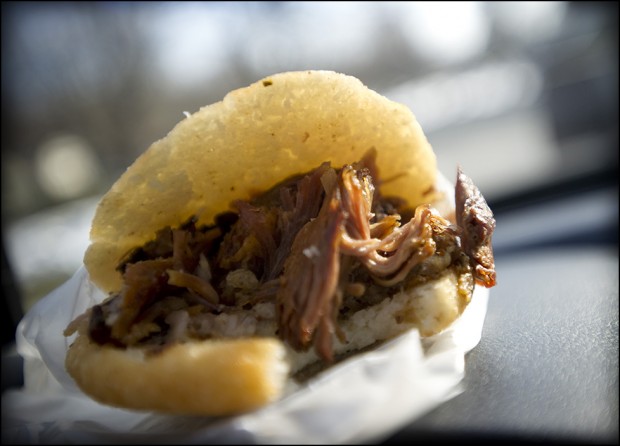 Curious? That is the name of the avocado sauce that we discovered last Sunday at Valencia Luncheria, a Venezuelan beach food cafe in New Canaan, Connecticut. We showered it over every dish. The first recipe (and photo) I found for it on the web was a thick grassy green, creamy pesto and not at all like the milky, squeeze-bottle, cilantro flecked sauce we experienced there. So I decided to try my hand at reproducing it. It's hard enough to find a super ripe avocado exactly when you want to use it, but amongst a hill of them in a local supermarket I found one. One. A small one. I knew there was a background flavor of onion, vinegar or lime juice, lots of cilantro and a bit of spiciness. And I knew that the emulsifier here was water, not the cup of olive oil in the aforementioned recipe. First the sauce tasted a bit "sweet" according to my husband, the globe-trotting restaurant consultant who has an immaculate palate. There was nothing sweet in it but he was right. Time for more vinegar, and some healthy squeezes of fresh lime juice. Definitely more salt, and a little more onion. Ahh, a bit more minced fresh jalapeno; after all, they vary so much in their heat index. Hmm. The sauce at VL was also a bit pale, so in addition to water I added some milk. Unorthodox maybe, but before we knew it, in our very own kitchen was a small glass pitcher of our own homemade guasacaca! A heaping cup, or more of it -- a milky, jade-green sauce with flecks of kelly green cilantro. We poured it over a mound of steaming, freshly cooked black beans, laced with fresh bay and garlic. We ate some steamed carrots and cabbage. We drank some chilled white wine and repeated what we often say to each other at dinner, that "no one else on the planet is eating this right now."
My husband found another recipe for me at the end of the evening. It was from Steven Raichlen, the super prolific cookbook author, whose recipe, it turns out, was very similar to mine. His uses chopped green bell pepper instead of my jalapeno (in a smaller quantity) and he, too, uses a large quantity of water to loosen it. It is the Venezuelan steakhouse equivalent to Argentina's chimichurri and it can be enjoyed on almost anything, even a hill of beans.
Curious? That is the name of the avocado sauce that we discovered last Sunday at Valencia Luncheria, a Venezuelan beach food cafe in New Canaan, Connecticut. We showered it over every dish. The first recipe (and photo) I found for it on the web was a thick grassy green, creamy pesto and not at all like the milky, squeeze-bottle, cilantro flecked sauce we experienced there. So I decided to try my hand at reproducing it. It's hard enough to find a super ripe avocado exactly when you want to use it, but amongst a hill of them in a local supermarket I found one. One. A small one. I knew there was a background flavor of onion, vinegar or lime juice, lots of cilantro and a bit of spiciness. And I knew that the emulsifier here was water, not the cup of olive oil in the aforementioned recipe. First the sauce tasted a bit "sweet" according to my husband, the globe-trotting restaurant consultant who has an immaculate palate. There was nothing sweet in it but he was right. Time for more vinegar, and some healthy squeezes of fresh lime juice. Definitely more salt, and a little more onion. Ahh, a bit more minced fresh jalapeno; after all, they vary so much in their heat index. Hmm. The sauce at VL was also a bit pale, so in addition to water I added some milk. Unorthodox maybe, but before we knew it, in our very own kitchen was a small glass pitcher of our own homemade guasacaca! A heaping cup, or more of it -- a milky, jade-green sauce with flecks of kelly green cilantro. We poured it over a mound of steaming, freshly cooked black beans, laced with fresh bay and garlic. We ate some steamed carrots and cabbage. We drank some chilled white wine and repeated what we often say to each other at dinner, that "no one else on the planet is eating this right now."
My husband found another recipe for me at the end of the evening. It was from Steven Raichlen, the super prolific cookbook author, whose recipe, it turns out, was very similar to mine. His uses chopped green bell pepper instead of my jalapeno (in a smaller quantity) and he, too, uses a large quantity of water to loosen it. It is the Venezuelan steakhouse equivalent to Argentina's chimichurri and it can be enjoyed on almost anything, even a hill of beans.
My Own Guasacaca The sauce should be highly seasoned, so taste as you go along and make adjustments: add more jalapeno, vinegar or salt.
1 small ripe avocado, about 7 ounces 1/2 cup chopped cilantro 2 tablespoons chopped onion 1 small garlic clove 1 tablespoon rice vinegar 1 to 2 tablespoons fresh lime juice 1 to 2 teaspoons finely minced fresh jalapeno 1 cup water 1/2 cup milk lots of kosher salt to taste
Process the first 7 ingredients in a food processor until smooth. Slowly add the water and milk until the sauce is pourable. Add salt to taste. Makes about 1-1/2 cups
